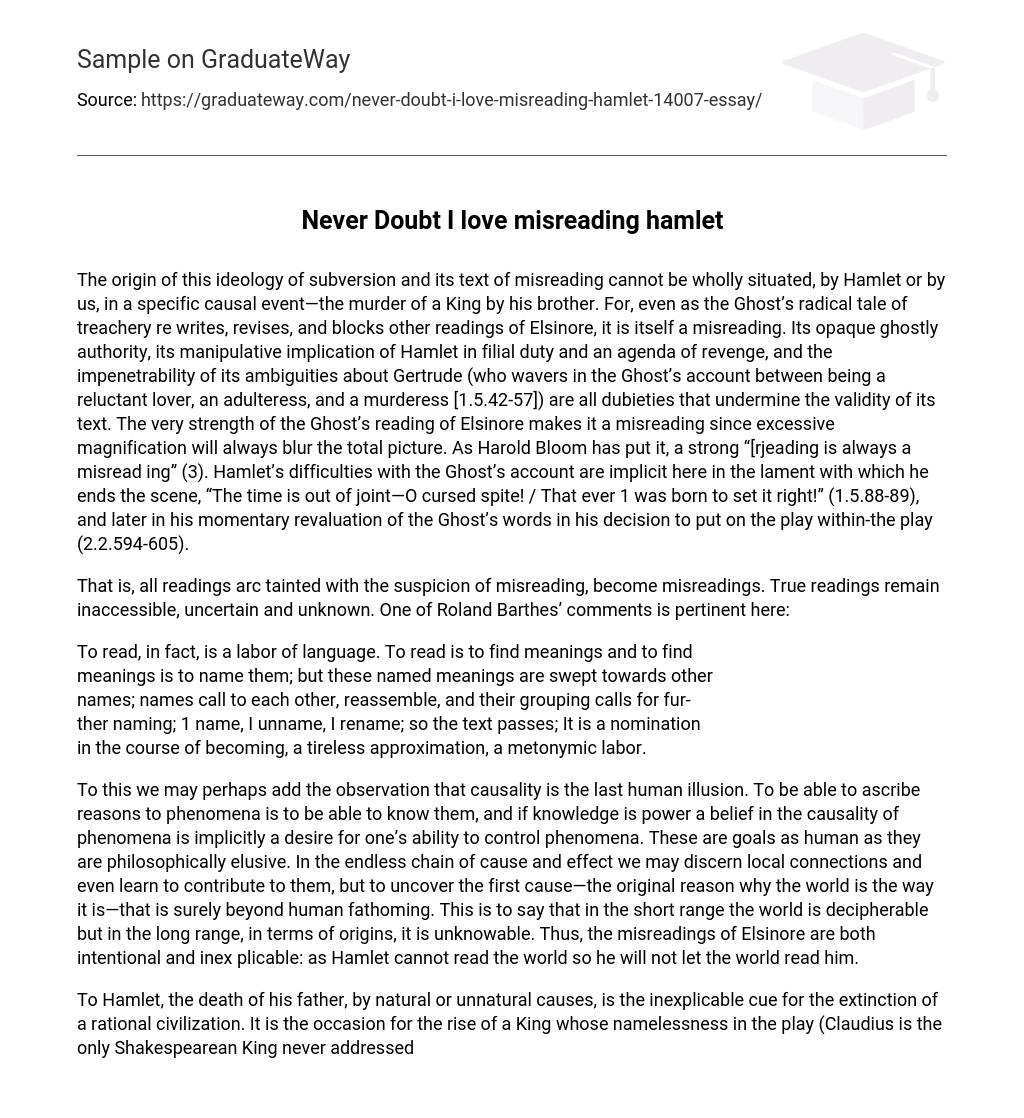The origin of this ideology of subversion and its text of misreading cannot be wholly situated, by Hamlet or by us, in a specific causal event—the murder of a King by his brother. For, even as the Ghost’s radical tale of treachery re writes, revises, and blocks other readings of Elsinore, it is itself a misreading. Its opaque ghostly authority, its manipulative implication of Hamlet in filial duty and an agenda of revenge, and the impenetrability of its ambiguities about Gertrude (who wavers in the Ghost’s account between being a reluctant lover, an adulteress, and a murderess [1.5.42-57]) are all dubieties that undermine the validity of its text. The very strength of the Ghost’s reading of Elsinore makes it a misreading since excessive magnification will always blur the total picture. As Harold Bloom has put it, a strong “[rjeading is always a misread ing” (3). Hamlet’s difficulties with the Ghost’s account are implicit here in the lament with which he ends the scene, “The time is out of joint—О cursed spite! / That ever 1 was born to set it right!” (1.5.88-89), and later in his momentary revaluation of the Ghost’s words in his decision to put on the play within-the play (2.2.594-605).
That is, all readings arc tainted with the suspicion of misreading, become misreadings. True readings remain inaccessible, uncertain and unknown. One of Roland Barthes’ comments is pertinent here:
To read, in fact, is a labor of language. To read is to find meanings and to find
meanings is to name them; but these named meanings are swept towards other
names; names call to each other, reassemble, and their grouping calls for fur-
ther naming; 1 name, I unname, I rename; so the text passes; It is a nomination
in the course of becoming, a tireless approximation, a metonymic labor.
To this we may perhaps add the observation that causality is the last human illusion. To be able to ascribe reasons to phenomena is to be able to know them, and if knowledge is power a belief in the causality of phenomena is implicitly a desire for one’s ability to control phenomena. These are goals as human as they are philosophically elusive. In the endless chain of cause and effect we may discern local connections and even learn to contribute to them, but to uncover the first cause—the original reason why the world is the way it is—that is surely beyond human fathoming. This is to say that in the short range the world is decipherable but in the long range, in terms of origins, it is unknowable. Thus, the misreadings of Elsinore are both intentional and inex plicable: as Hamlet cannot read the world so he will not let the world read him.
To Hamlet, the death of his father, by natural or unnatural causes, is the inexplicable cue for the extinction of a rational civilization. It is the occasion for the rise of a King whose namelessness in the play (Claudius is the only Shakespearean King never addressed either by his official title [Calderwood xvj or by his name [Goldberg 326)), matches the equivocal blankness of his speech (as for instance, in 1.3). That death is the setting for the rise of a world in which a celestially angelic Gertrude, a “Niobe” in her “tears,” can be with the “satyr,” Claudius, as readily as she wras with the “Hyperion” that was her husband (1.2.140-49). This is a world in which, from behind the pomp and glit ter of a coronation ceremony, the riddle of incest decouples things from their names, thoughts from their expression, and ideas from their representation.
But this event—the death of his father—cannot be given any status save that of a desultory event. It cannot be afforded any attribute of causality because causality has the legibility of logic that is denied by the world that Hamlet con fronts. The subversion and misreadings of Elsinore are, in other words, cause less, a random phenomenon in the dynamics of chaos. For reasons unknown, Elsinore and the world have become unreadable to Hamlet, and with that Hamlet has become unreadable to others and to himself. In this sense, the text of misreading that Hamlet affirms in his poem is his horrible practical joke, his real gruesome revenge upon the world for the incomprehensibility of its text.
This, we note, is a revenge that Hamlet’s audience would relish, for, as Stephen Orgel has recently pointed out, “the Renaissance often found in incomprehen sibility a positive virtue” (436). Indeed, in his poem Hamlet exemplifies Montaigne’s words from “On the Inconsistency of Our Actions”: “I have nothing to say about myself absolutely, simply and solidly, without confusion and without mixture, or in one word” (242).





